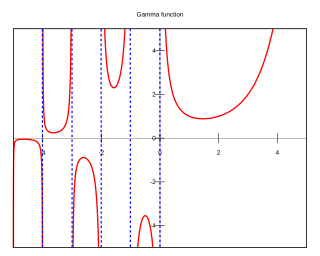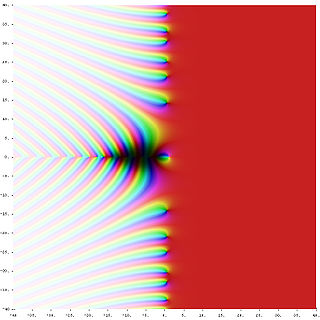In mathematics, Matsumoto zeta functions are a type of zeta function introduced by Kohji Matsumoto in 1990. They are functions of the form
where p is a prime and Ap is a polynomial.
In mathematics, Matsumoto zeta functions are a type of zeta function introduced by Kohji Matsumoto in 1990. They are functions of the form
where p is a prime and Ap is a polynomial.

In mathematics, the gamma function is one commonly used extension of the factorial function to complex numbers. The gamma function is defined for all complex numbers except the non-positive integers. For any positive integer n,
In mathematics, the prime number theorem (PNT) describes the asymptotic distribution of the prime numbers among the positive integers. It formalizes the intuitive idea that primes become less common as they become larger by precisely quantifying the rate at which this occurs. The theorem was proved independently by Jacques Hadamard and Charles Jean de la Vallée Poussin in 1896 using ideas introduced by Bernhard Riemann.

The Riemann zeta function or Euler–Riemann zeta function, denoted by the Greek letter ζ (zeta), is a mathematical function of a complex variable, and can be expressed as:
In complex analysis, a branch of mathematics, analytic continuation is a technique to extend the domain of definition of a given analytic function. Analytic continuation often succeeds in defining further values of a function, for example in a new region where an infinite series representation in terms of which it is initially defined becomes divergent.

In probability theory and statistics, the zeta distribution is a discrete probability distribution. If X is a zeta-distributed random variable with parameter s, then the probability that X takes the integer value k is given by the probability mass function
The Riemann hypothesis is one of the most important conjectures in mathematics. It is a statement about the zeros of the Riemann zeta function. Various geometrical and arithmetical objects can be described by so-called global L-functions, which are formally similar to the Riemann zeta-function. One can then ask the same question about the zeros of these L-functions, yielding various generalizations of the Riemann hypothesis. Many mathematicians believe these generalizations of the Riemann hypothesis to be true. The only cases of these conjectures which have been proven occur in the algebraic function field case.

In mathematics, analytic number theory is a branch of number theory that uses methods from mathematical analysis to solve problems about the integers. It is often said to have begun with Peter Gustav Lejeune Dirichlet's 1837 introduction of Dirichlet L-functions to give the first proof of Dirichlet's theorem on arithmetic progressions. It is well known for its results on prime numbers and additive number theory.
In complex analysis, Liouville's theorem, named after Joseph Liouville, states that every bounded entire function must be constant. That is, every holomorphic function for which there exists a positive number such that for all in is constant. Equivalently, non-constant holomorphic functions on have unbounded images.
In mathematics, a Dirichlet series is any series of the form

In mathematics, the Hurwitz zeta function is one of the many zeta functions. It is formally defined for complex variables s with Re(s) > 1 and a ≠ 0, −1, −2, ... by
Matsumoto may refer to:

In mathematics, the universality of zeta functions is the remarkable ability of the Riemann zeta function and other similar functions to approximate arbitrary non-vanishing holomorphic functions arbitrarily well.
In mathematics, the explicit formulae for L-functions are relations between sums over the complex number zeroes of an L-function and sums over prime powers, introduced by Riemann (1859) for the Riemann zeta function. Such explicit formulae have been applied also to questions on bounding the discriminant of an algebraic number field, and the conductor of a number field.
In mathematics, a natural number a is a unitary divisor of a number b if a is a divisor of b and if a and are coprime, having no common factor other than 1. Thus, 5 is a unitary divisor of 60, because 5 and have only 1 as a common factor, while 6 is a divisor but not a unitary divisor of 60, as 6 and have a common factor other than 1, namely 2. 1 is a unitary divisor of every natural number.

The infinite series whose terms are the natural numbers 1 + 2 + 3 + 4 + ⋯ is a divergent series. The nth partial sum of the series is the triangular number
In mathematics, the multiple zeta functions are generalisations of the Riemann zeta function, defined by

In mathematics, the Riemann hypothesis is a conjecture that the Riemann zeta function has its zeros only at the negative even integers and complex numbers with real part 1/2. Many consider it to be the most important unsolved problem in pure mathematics. It is of great interest in number theory because it implies results about the distribution of prime numbers. It was proposed by Bernhard Riemann (1859), after whom it is named.
In mathematics, the main conjecture of Iwasawa theory is a deep relationship between p-adic L-functions and ideal class groups of cyclotomic fields, proved by Kenkichi Iwasawa for primes satisfying the Kummer–Vandiver conjecture and proved for all primes by Mazur and Wiles (1984). The Herbrand–Ribet theorem and the Gras conjecture are both easy consequences of the main conjecture. There are several generalizations of the main conjecture, to totally real fields, CM fields, elliptic curves, and so on.
Kohji Matsumoto is a mathematician, Doctor of Mathematics, and professor of mathematics at Nagoya University in Nagoya, Japan. His specializations include number theory, zeta theory, and mathematical analysis. He is mostly recognized for the Matsumoto zeta function, a zeta function named after him. His academic papers have been published in several scientific journals. He co-edited Analytic Number Theory, a tome about prime numbers, divisor problems, Diophantine equations, and other topics related to analytic number theory, including Diophantine approximations, and the theory of zeta and L-functions. His other book, Algebraic And Analytic Aspects Of Zeta Functions And L-Functions, a compilation of lectures at the French-Japanese Winter School, was published in 2010.